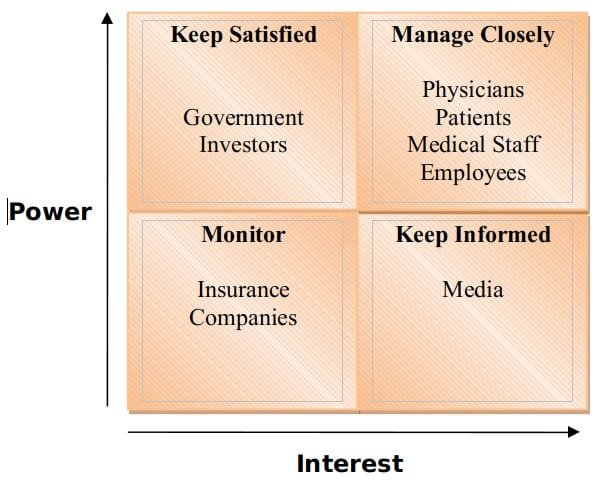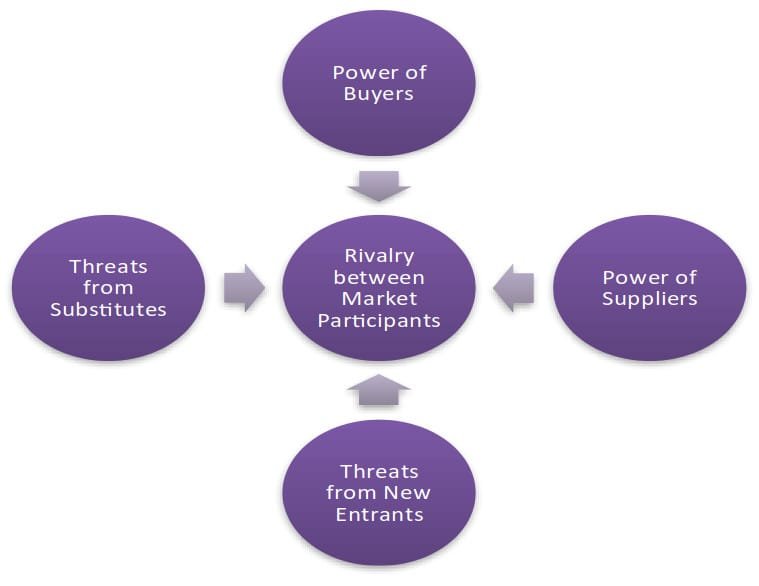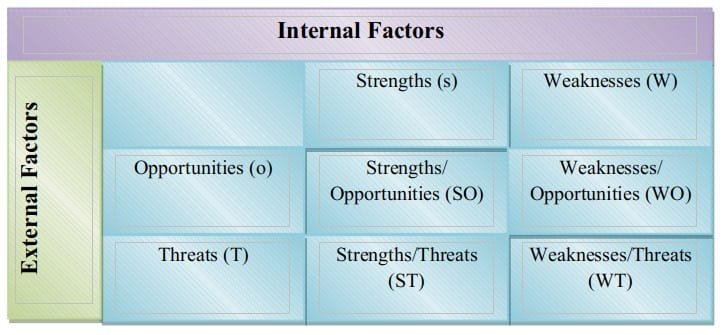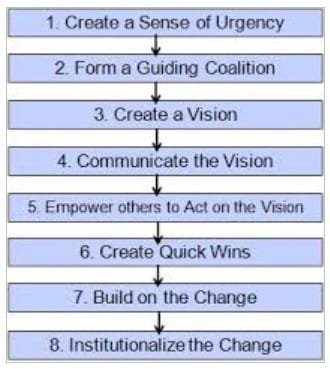Strategy Formulation and Management of Change Application to a Healthcare Organisation

Introduction
This paper aims to outline and detail the theories, tools, ways and means that can be used by a healthcare manager to formulate strategy in a healthcare organisation. The application of strategy to a particular business sector makes it easier to understand its practical implications than a generalised discussion.
A strategy essentially comprises a specific method or plan that is adapted to create a desired future, especially the achievement of a goal (Mintzberg & Quinn, 1996). Freedman (2013) stated that organisations essentially develop strategies to fulfil the objectives of their various stakeholders. An organisational stakeholder in the business context is an individual organisation or entity that has an interest in an organisation and can affect or be affected by a business (Capon, 2008). Whilst shareholders are frequently considered to be very important stakeholders, the list is broad and includes members of the organisational management, employees, customers, suppliers and regulators, amongst others (Jenkins et al., 2007).
Strategic management is concerned with the management of organisational resources for the achievement of goals and objectives (Thompson, 2010). It involves the setting and establishment of objectives, the analysis of the competitive environment, the study of the internal organisation, the development of various strategic alternatives, and finally the implementation and monitoring of strategic implementation (Capon, 2008).
Strategic planning has become critically imperative in healthcare organisations, which are currently engaged in satisfying increasingly demanding users and in changing their internal organisation in order to keep pace with the swift alterations that are occurring in technology and business approaches (Zuckermann, 2005). Healthcare organisations need to engage in strategic planning and management because of various reasons, including clients who are informed, demanding and have the capacity to choose, skilled and professional competitors, limited production and other resources, the shifting of focus from the product or service to the client, the achievement of client satisfaction and the increasing size and complexity of healthcare organisations (Ginter et al., 2002). Engagement in strategic planning and management can help in the establishment of clear organisational direction, the revelation of hidden opportunities and threats, the development of a specific framework with the criteria for optimising decision making and the enhancement of the participation and commitment of the entire healthcare organisation in the achievement of planned results.
Development of Strategy
This section deals with the development of strategy in healthcare organisations. The process is essentially complex and comprises several steps, which have been taken up and explained in a sequential manner.
Stakeholder Analysis
Saint Joseph’s University (2011) stated that the major stakeholders in healthcare organisations were physicians, medical staff, patients, employers, insurance companies, pharmaceutical organisations and the government. Insurance companies sold health coverage plans directly to patients or otherwise through employers or various government intermediaries. Pharmaceutical organisations developed and thereafter marketed medications that were prescribed by doctors for the treatment of patients (Auvinen, 2016). Several employers provide health insurance coverage with differing deductibles for employees (Bierboom et al., 2016). Physicians provide medical care, whereas patients receive it (Auvinen, 2016). The government subsidises healthcare for the poor, disabled and the elderly. All stakeholders have specific duties and responsibilities (Auvinen, 2016).
Stakeholder mapping is a process for the identification of key stakeholders in order to ensure their appropriate management (Ginter et al., 2002). The following diagram provides a stakeholder map for a healthcare organisation.
Chart 1: Stakeholder Map
(Source: Adapted from Bierboom et al., 2016, p634)
Definition of Mission, Vision and Values
It is important to commence the strategic planning and management exercise with the development of the organisational mission, vision and values (Johnson et al., 2014). The organisational mission comprises a written statement that defines a final objective of the healthcare organisation (Cox, 2011). It defines the overall organisational purpose, targeted clients, offered services and their distinguishing features, as well as issues like ethics, quality and efficiency (Hutzschenreuter & Kleindienst, 2006). The mission statement should be circulated throughout the organisation in order to ensure that all members of the workforce know it comprehensively (Pitt & Koufopoulous, 2012). Clients should also be informed of the mission statement as it constitutes an organisational commitment to its tasks. The vision statement constitutes a written statement that creates a future image of the healthcare organisation after its transformation (Akinyele &Fasogbon, 2007). It should specifically declare the aspirations of the organisation in the future and serve to inspire, attract and motivate organisational members (Hutzschenreuter& Kleindienst, 2006).
Values constitute sets of principles and rules, which constitute the ethical code of a healthcare organisation (David, 2005). They predict specific responses when situations needing immediate resolution emerge and should be shared and disseminated (Raduan et al., 2009)./p>
Analysis of External Environment
It is important for an organisation to examine and analyse its external environment in detail in order to formulate an effective strategy (Ansoff & Nakamura, 2007). The analysis of the external environment is a complex activity, which involves the identification and examination of several factors in order to assess their impact on organisational working (Freedman, 2013). David (2005) stated that such an analysis should first focus on the analysis of clients, competitors, providers and owners. These four dimensions are termed the business sector and propose a comprehensive picture of the environment. It is important to identify clients and their expectations (Thompson, 2010). Competitors should be clearly identified and analysed and subsequently compared with the working of the healthcare organisation itself (White, 2004). Such competitors constitute a major source of learning for the organisation (Capon, 2008). Suppliers provide necessary organisational resources and it is important to differentiate them in order to optimise the cost and quality of provided services (Jenkins et al., 2007). Apart from such analysis, the examination of the external environment also entails the study and analysis of six specific macro environmental factors, namely political, economic, social, technological, environmental and legal factors that can influence organisational strategy and work.
The PESTEL analysis for a modern UK based healthcare organisation is carried out below.
Table 1: PESTEL Analysis
Macro Environmental Factors | Details |
Political | The current UK government is committed to the reduction of public spending. The focus on sharing of services by the government implies that IT services will be provided across several organisations comprising millions of people. Doctors are also increasingly being provided with responsibilities. |
Economic | The European economy is expected to be sluggish and low growth in the coming years, which may have adverse implications for future investment. Healthcare organisations will be expected to continue to control costs and at the same time modernise their systems. |
Social | The average age of the population in the UK and Europe is steadily increasing, which is expected to put greater stress on the healthcare system. It is expected that long term conditions like diabetes, cardiac ailments and obesity will increase and could overlap with social care, namely Alzheimer’s disease. |
Technological | The medical environment is experiencing significant technological advances and modern healthcare organisations will have to continuously invest and upgrade the technology in the provisioning of care, as well as in the area of information systems. |
Environmental | The UK government is continuously focusing on enhancement of environmental safeguarding and healthcare organisations, clinics and hospitals will be required to continuously reduce the adverse environmental impact of their operations. |
Legal | It is expected that clinical safety directives and medical legislation will continue to impact the industry in various ways. |
(Source: Emmerson, 2018; Eurostat, 2018; Deloitte Development LLC, 2017; NEJM Catalyst, 2018; European Medicines Agency, 2018).
Healthcare organisations must simultaneously engage in a comprehensive analysis of the internal environment in order to successfully formulate and manage their strategies. Michael Porter (1980) has advanced a model, which entails a dynamic complementary analysis. The Porter’s Five Forces model involves the examination and study of five specific environmental features, namely (1) the bargaining power of clients, (2) the bargaining power of suppliers, (3) threats from new entrants and entry barriers, (4) threats from alternate products and services and (5) rivalry between market participants (Vaara & Whittington, 2012). The application of Porter’s five forces model entails an examination of the microenvironment of the organisation and helps in understanding the extent of competitiveness in a specific sector.
Chart 2: Porter’s Five Forces Analysis
(Source: Adapted from Grant, 2012, p49)
Analysis of Internal Environment
The examination of the internal environment should be followed by an analysis of the internal environment (McGee et al., 2005). Such an analysis helps in the provisioning of information on issues that are relevant and have occurred within the healthcare organisation, it is accepted that the organisation is capable of acting upon, transforming and changing its internal environment. Such an analysis needs to focus on four specific areas, namely resources, the legal situation, other power groups and clinical care, training and research activity (Cox & Rawlinson, 2008). It is important to analyse the organisation’s available resources, including people, structural resources like plant and equipment and finances. An analysis of the legal situation, especially the role of current regulations is important to understand what can and cannot be taken up for implementation in the future (Capon, 2008). It is also necessary to examine power groups within the healthcare organisation, including clinical commissions, decision making bodies, professional associations and trade unions on account of their role in organisational work and activity. It is essential to know the extent of their impact and influence on operations. Apart from the above, organisational managements should engage in the analysis of clinical care, training and research activity over an adequate period in order to identify trends that could be relevant in the making of strategic decisions. The information should be synthesised in order to identify relevant issues and the need for making strategic decisions (White, 2004).
Development of the SWOT Matrix
The conduct of external and internal analysis is likely to result in the generation of substantial information and several ideas about possible strategic activities that could be taken up and addressed in the course of determination of the strategic plans (Hill & Jones, 2012). The issues taken up and identified in the external and internal analysis are thereafter classified into four categories, namely strengths, weaknesses, opportunities and threats in order to understand what needs to be done and the order of doing them (Pearce, 2006). The conduct of the external analysis leads to the identification of opportunities and threats, whereas the examination of the internal environment helps in the classification and identification of strengths and weaknesses (Hill & Jones, 2012). The use of a SWOT table helps in the development of clarity on four extremely important organisational issues and assists in the formulation of strategy (Grant, 2012). The following table depicts the conduct of a SWOT analysis for a modern healthcare organisation.
Table 2: SWOT Analysis
Strengths
| Weaknesses
|
Opportunities
| Threats
|
(Source: European Medicines Agency, 2018; NEJM Catalyst, 2018; Deloitte Development LLC, 2017)
Development of Strategic Alternative
The next step in the strategic management process is the development of strategic alternatives and options, followed by the appraisal of options and the development of strategic objectives (De Wit & Meyer, 2014). The development of strategic alternatives is by and large carried out through the use of a TOWS analysis, advanced by Albert Humphrey in the 1960s at the Stanford Business School (Hill & Westbrook, 1997). The conduct of a TOWS analysis helps in the generation, comparison and analysis and selection of organisational strategies. The following diagram depicts a TOWS matrix (Grashaw, 2011).
Chart 3: TOWS Matrix
(Source: Adapted from Grashaw, 2011, p47)
The development of a TOWS matrix helps in the generation of four types of strategies, which are detailed below.
- Strength/Opportunity (SO): The utilisation of strengths for the exploitation of opportunities
- Weakness/Opportunity (WO): The reduction of weaknesses for the exploitation of opportunities
- Strengths/Threats (ST): The exploitation of strengths for the overcoming of potential threats
- Weaknesses/Threats (WT): The minimisation of weaknesses for the avoidance of potential threat
The use of the TOWS matrix for the development of strategies helps in the generation of various types of strategic alternatives and options (Fine, 2009). These options have to be appraised and examined in detail in order to rank and prioritise them carefully and thereby decide upon the most viable and preferred strategies (Fine, 2009). Rummelt (1980) stated that strategic options should be evaluated against four types of generic criteria, namely consonance, consistency, feasibility advantage. Several strategic analysts make use of options appraisal tables in order to decide upon the most suitable option (Dess, 2006). An options appraisal table essentially represents the examination of various options followed by their appropriate ranking (Grashaw, 2011). The following table provides an illustration of an options appraisal table for a healthcare organisation.
Table 3: Option Appraisal Table for Healthcare Organisation
Option | Qualitative Score (1-10) | Quantitative Score (1-10) | Total Score (1-20) | Ranking |
Option 1 | ||||
Option 2 | ||||
Option 3 | ||||
Option 4 | ||||
Option 5 |
(Source: Adapted from Grashaw, 2011, p17)
Operational Planning
The aim of strategic planning is to ensure that every prioritised and finalised strategic objective becomes clearly specific, practical and recognisable (Day & Moorman, 2010). This calls for the assignment of operational objectives to each specific strategic objective (David, 2013). The operational objectives must be specific and clear and have some particular characteristics.
- They should be specific, fixed and have clear duration, which should be less than a year. Intermediate goals can also be established.
- They should be very clearly quantified and measurable.
- They should be challenging in nature and aim to keep the organisation alert and ready to achieve them.
- Each of the objectives should be assigned to a designated person.
- Each objective should be assigned and provided with an implementation cost such that the total cost of the objectives equals the total expense outlay for the specific plan.
- Each objective should be provided with adequate funding to ensure its achievement (Day & Moorman, 2010).
It is furthermore necessary to integrate all the objectives and develop a timeline of action in order to ensure that the healthcare organisation can tackle them adequately and ensure their satisfactory completion.
Monitoring and Assessment of Results
It is important to ensure that strategies are carefully followed through after their preparation in order to ensure their satisfactory completion. Whilst the technique for strategy formulation, described above is methodical and objective in nature, it can be considered to be an imperfect process on account of various factors, including the evaluation and choice of strategic objectives, insufficient evaluation of factors and errors in the assessment of external and internal environmental factors. It is thus necessary to appoint a steering group and put it in place in order to examine, monitor and track the extent of achievement of different objectives. Such tracking is generally carried out by obtaining both internal implementations on implementation and external information on the environment. The assessment of the results of strategic monitoring should furthermore be carried out on a collective basis and meetings must be held periodically in order to identify delays and take corrective action. Such monitoring, it should be recognised, may result in changes in the original objectives.
Importance of Innovation
Innovation has been described as the “designing, invention, development and implementation of new or altered products, services, processes, systems, organisational structures or business models for the purpose of creation of new value for customers and financial returns for an organisation” (Smith, 2010, p7). Perceived comprehensively, it essentially constitutes the development and implementation of new or improved products and services (Conway & Steward, 2006). It also includes the development of new ways of service delivery, organisational, marketing approaches and ways of relating to customers (Trott, 2011). Schumpeter (1934) stated that innovation can be segmented as non-disruptive or disruptive. The former, i.e. non-disruptive innovation is essentially incremental, evolutionary or sustaining in nature; it results in the improvement of an existing product, service or process. Disruptive or radical innovation is essentially transformational and revolutionary in nature and includes innovations that essentially result in the disruption of old systems, the marginalising of old markets, the creation of new ones and the delivery of new value opportunities to innovators (Smith, 2010). Porter-O’Grady and Malloch (2010) stated that healthcare is expected to experience substantial disruptive innovation in the coming years. There is little doubt that healthcare has experienced numerous innovations in recent decades on account of enhancement in therapeutic and diagnostic options; these innovations have focused on the enhancement of life expectancy and improvement in life quality (Fleuren et al., 2004). With contemporary healthcare organisations facing significant pressure to enhance quality, improve access, augment efficiency, minimise waste and reduce costs, innovation is an area of tremendous focus.
Several forces are driving this need for innovation. The traditional care delivery model, which is encounter base, is facing pressure on account of the expansion in demand; this is being driven by the swiftly increasing incidence of chronic disease and retiring baby boomers (Tiedeman & Lookinland, 2004). Shortages have developed in areas of key providers and costs are increasing steadily. The bulk of innovation in healthcare has focused on the generation of new therapies, drugs, diagnostic procedures and medical devices (Fleuren et al., 2004). Such advances include the creation of new pharmaceutical agents and procedures like stents to surgical robots and diagnostic scanners (Tiedeman & Lookinland, 2004). The focus on innovation, going forward is expected to accelerate swiftly and result in significant changes in several areas, including prevention, increasingly personalised care, care models that are technically enabled, comprehensive delivery and technologically enabled options for more effective health encounters. Porter-O’Grady and Malloch (2010) stated that technology has played an extremely important role in the past in healthcare innovation and this is not expected to change in future. Innovation is thus likely to play an extremely critical role in healthcare strategic decision making and the appraisal of various strategic options.
Change Management Theory
Strategic management involves the examination of various aspects of the internal and external environment, the crystallisation of strengths, weaknesses, opportunities and threats, the generation of diverse strategic options and alternatives, the selection of the best possible strategies and their effective implementation for the achievement of organisational vision and mission (Balogun, 2008). It is important to keep in mind that the development of strategies and their subsequent implementation can result in significant organisational change, as also the generation of change resistance. Several management experts like Peter Drucker, Michael Porter and Jack Welch have repeatedly written about the necessity for organisations to initiate beneficial organisational change (Hayes, 2014). The failure to do so can very clearly result in organisational stagnation and obsolescence with several consequential outcomes for the reduction of competitive advantage (Balogun, 2008). Research has, however, revealed that the majority of organisational initiatives for bringing about beneficial change end in partial or complete failure (Kotter & Cohen, 2002). Whilst change initiative can fail on account of various reasons, including mistakes in the formulation of change management strategies and errors in allocation of resources, an extremely important cause of change management failure is organisational change.
There is wide agreement that the bringing about of rapid and widespread organisational change can result in various types of objections and resistance by employees and other stakeholders, who may in all likelihood, feel that such changes could threaten their professional and personal lives in different ways (Kotter & Cohen, 2002). Organisational managements thus need to place considerable stress on the successful implementation of change management because the failure to do so can result in the underachievement or the failure of strategic plans and in the accomplishment of strategic objectives (Hughes, 2006). Modern organisational managements thus tend to make use of specific change management frameworks for the achievement of organisational change objectives (Hayes, 2014). Two popular change management models are the Lewin Change Management Model and the Kotter Eight Step Change Management framework. The Lewin change management model is essentially a three-step framework, which involves (1) unfreezing of the current environment, (2) implementation of the change initiative and (3) refreezing of organisational activity (Lewin, 1951). The following diagram depicts the three-stage Lewin change management model.
Chart 4: Lewin’s Change Management Model
(Source: Hayes, 2014, p107)
Kotter (1995) built upon Lewin’s work and developed an eight-step change management model that can help organisations in comprehensively bringing about change. His eight-step model is illustrated in the following diagram.
Chart 5: Kotter’s Eight-Step Change Management Framework
(Source: Kotter, 1995, p 7)
Kotter (1995) stated that a change management initiative should essentially commence with the creation of a sense of urgency to bring about change. This should be followed by the formation of a powerful guiding coalition, the development of a comprehensive vision and strategy, the communication of such a vision, the removal of various types of objections through careful identification of change resistance spots and the rewarding of people for endorsing change, the creation of short term wins, the consolidation of gains, and the anchoring of change in the organisational culture. Both the Lewin and the Kotter change management models have received wide acceptance and are used by several organisationsin the implementation and management of beneficial organisational change.
Conclusions
This paper aimed to examine and analyse various aspects of strategic management and develop a strategic plan for the implementation of appropriate strategies for a contemporary healthcare organisation. There is little doubt that the formulation and implementation of the organisational strategy are extremely important for the successful growth, expansion and profitability of modern organisations, including those in the healthcare sector. The organisational level at which strategic planning is relevant can differ from organisation to organisation and could include a cardiology department or an electrophysiology unit, keeping in mind that their plans should be in alignment with plans at higher levels. Cox and Rawlinson (2008) stated that the leader of the healthcare organisation or the specific unit should be responsible for initiating and overseeing the strategic planning and management process. The examination carried out for this particular paper revealed that the process was essentially rational, systematic and holistic. It involved the integration of the short, the medium and the long term and thereby enabled the healthcare organisation to essentially focus on bringing about relevant, beneficial and lasting change for the future. The examination revealed that the planning and implementation of strategy involved the formulation of mission, vision and values, the examination and analysis of the internal and external environment of an organisation, the crystallisation of SWOT features, the development and prioritisation of strategic alternatives and their careful subsequent implementation in order to achieve organisational objectives. The paper also took up the discussion of innovation and its relevance for the strategy of healthcare organisations and change management theory and practice, with specific regard to strategic management.
References
Akinyele, S.T., &Fasogbon, O.I., (2007), “Impact of Strategic Planning on Organizational Performance and Survival”, Research Journal of Business Management, Vol. 1: pp. 62-71.
Ansoff, I., & Nakamura, I. G., (2007), Strategic Management Classic Edition, 1st edition, UK: Palgrave Macmillan.
Ari-Matti Auvinen, (2016), “Understanding the Stakeholders as a Success Factor for Effective Occupational Health Care”, Available at: https://www.intechopen.com/books/occupational-health/understanding-the-stakeholders-as-a-success-factor-for-effective-occupational-health-care (accessed March 15, 2019).
Balogun, J., (2008), Exploring Strategic Change, 3rd Edition, Harlow: Prentice Hall.
Bierbooms, J., Van Oers, H., Rijkers, J., &Bongers, I., (2016), “Development of a comprehensive model for stakeholder management in mental healthcare”, Journal of Health Organization and Management, Vol. 30, Iss (4): pp.630-647.
Capon, C., (2008), Understanding Strategic Management, Harlow: FT Prentice Hall.
Conway, S., & Steward, F., (2006), Managing Innovation, Oxford:Oxford University Press.
Cox, Y., (2011), “Developing a Strategy for Implementation of Policy”, In Coles, L. Porter E, (Eds) Transforming Public Health Practice: Practice Policy and Strategy for Improving Health and Wellbeing, Exeter: Learning Matters.
Cox, Y., & Rawlinson, M., (2008), “Strategic Leadership for Health & Wellbeing” in Coles,L. Porter, E. (Eds) Public Health Skills: A practical guide for Nurses and Public Health Practitioners, Oxford: Blackwell Publishing.
David, F.R., (2005), Strategic Management: Concepts and Cases, NJ: Prentice Hall.
Day, S.G., & Moorman, C., (2010), Strategy from the Outside In: Profiting from Customer Value, NY: McGraw-Hill Professional.
Deloitte Development LLC, (2017), “The hospital of the future How digital technologies can change hospitals globally”, Available at: https://www2.deloitte.com/content/dam/Deloitte/global/Documents/Life-Sciences-Health-Care/us-lshc-hospital-of-the-future.pdf (accessed March 15, 2019).
Dess, G., (2006), Strategic Management: Creating Competitive Advantage, London: McGraw-Hill.
De Wit, B., & Meyer, R., (2014), Strategy: an international perspective, 5th edition, London: Cengage learning.
Emmerson, E., (2018), “Two parliaments of pain: the UK public finances 2010 to 2017”, Available at: https://www.ifs.org.uk/publications/9180 (accessed March 15, 2019).
European Medicines Agency, (2018), “Clinical Trial Regulation”, Available at: https://www.ema.europa.eu/en/human-regulatory/research-development/clinical-trials/clinical-trial-regulation(accessed March 15, 2019).
Eurostat, (2018), “Population structure and ageing”, Available at: https://ec.europa.eu/eurostat/statistics-explained/index.php/Population_structure_and_ageing (accessed March 15, 2019).
Fine, G. L., (2009), The SWOT Analysis: Using your Strength to overcome Weaknesses, Using Opportunities to overcome Threats, London: Create Space.
Fleuren, M., Wiefferink, H.C., &Paulussen, C., (2004), “Determinants of innovation within health care organizations: Literature review and Delphi study”, International Journal for Quality in Health Care, Vol. 16, Iss (2): pp. 107-23.
Freedman, L., (2013), Strategy, Oxford: Oxford University Press.
Ginter, P.M, Swayne, L.E, & Duncan, W.J., (2002), Strategic management of healthcare organizations, 4th edition, Boston: Blackwell.
Grant, R.M., (2012), Contemporary Strategy Analysis, NY: John Wiley & Sons.
Grashaw, K., (2011), The value of the TOWS Matrix in strategy formulation. Do you agree with this way of generating strategic alternatives? Why or why not?, NY: Kurt Grashaw.
Hayes, J., (2014), The Theory and Practice of Change Management, 4th edition, Basingstoke: Palgrave Macmillan.
Hill, C.W.L., & Jones, G.R., (2012), Strategic Management Theory: An Integrated Approach, 10th edition, NY: Cengage Learning.
Hill, T., & Westbrook, R., (1997), “SWOT Analysis: It’s Time for a Product Recall”, Long Range Planning, Vol.30, Iss(1): pp. 46–52.
Hughes, M., (2006), Change Management: A Critical Perspective, London, UK: Chartered Institute of Personnel and Development.
Hutzschenreuter, T., & Kleindienst, I., (2006), “Strategy-process research: What have we learned and what is still to be explored”, Journal of Management, Vol. 32, Iss (5): pp. 673-720.
Jenkins, M., Ambrosini, V., Collier, N., (2007), Advanced Strategic Management: a multi-perspective approach, 2nd Edition, Wiltshire: Palgrave.
Johnson, G., Whittington, R., Scholkes, K., Angwin, D., &Regner, P., (2014), Exploring Strategy: Text and Cases, 10th Revised edition, NJ: Pearson.
Kotter, J.P., (1995), “Leading Change: Why Transformation Efforts Fail”, Harvard Business Review, Vol. 73, Iss (2): pp. 59-67.
Kotter, J.P., & Cohen, D.S., (2002), The Heart of Change: Real-life Stories of How People Change their Organizations, Boston, MA: Harvard Business Press.
Lewin K., (1951), Field Theory in Social Science: Selected Theoretical Papers, New York: Harper & Row.
McGee, J., Howard, T., & Wilson, D., (2005), Strategy: Analysis & practice, Mcgraw-Hill Education: Berkshire.
Mintzberg, H., & Quinn, J.B., (1996), The Strategy Process: Concepts, Contexts, Cases, NJ: Prentice Hall.
NEJM Catalyst, (2018), “What Is Risk Management in Healthcare?”, Available at: https://catalyst.nejm.org/what-is-risk-management-in-healthcare/ (accessed March 15, 2019).
Pearce, J.A., (2006), Strategic Management, New York: McGraw-Hill.
Pitt, M.R.,&Koufopoulous, D., (2012), Essentials of Strategic Management, London: Sage.
Porter, M. E., (1980), Competitive Strategy: Techniques for Analyzing Industries and Competitors, Free Press: New York.
Porter-O’Grady, T., & Malloch, K., (2010), Innovation leadership: Creating the landscape of Health Care, London: Jones & Bartlett Publisher.
Rumelt, R., (1980), “The evaluation of business strategy” in W.F. Glueck (ed), Business Policy and Strategic Management, New York: McGraw Hill.
Saint Joseph’s University, (2011), “Health Care Reform: Duties and Responsibilities of the Stakeholders”, Available at: https://sites.sju.edu/icb/health-care-reform-duties-and-responsibilities-of-the-stakeholders/ (accessed March 15, 2019).
Schumpeter, J. A., (1934), The theory of Economic Development, Cambridge, Mass: Harvard University Press.
Smith, D., (2010),Exploring Innovation, 2nd edition, NY: McGraw Hill.
Tiedeman, M.E., & Lookinland, S., (2004), “Traditional models of care delivery: what have we learned?”, Journal of Nursing Administration, Vol. 34, Iss (6): pp. 291-7.
Thompson, J.L., (2010), Strategic Management, 6th Edition, London: Thompson Learning.
Trott, P., (2011), Innovation Management and New Product Development, 5h edition, NJ: Financial Times/ Prentice Hall.
Vaara, E., & Whittington, R., (2012), “Strategy-as-practice: taking social practices seriously”, The Academy of Management Annals, Vol. 6, Iss (1): pp. 285-336.
White, C., (2004), Strategic Management, Basingstoke: Palgrave.
Zuckermann, A.M., (2005), Healthcare strategic planning, 2nd edition, Chicago: Health Administration Press.
More From This Category
Globalisation Challenges
Globalisation is the tendency of the public and economies to move towards greater economic, cultural, political, and technological interdependence. It is a phenomenon that is characterised by denationalisation, (the lessening of relevance of national boundaries) and is different from internationalisation, (entities cooperating across national boundaries). The greater interdependence caused by globalisation is resulting in an increasingly freer flow of goods, services, money, people, and ideas across national borders.
Does Capital Structure Matter
The capital structure of a modern corporation is, at its rudimentary level, determined by the organisational need for long-term funds and its satisfaction through two specific long-term capital sources, i.e. shareholder-provided equity and long-term debt from diverse external agencies (Damodaran, 2004). These sources, with specific regard to joint stock companies, retain their identity but assume different shapes.
Ethical and Governance Challenges for Businesses and Professionals
It is the duty of business organisations to refrain from engaging in actions that are harmful to their various stakeholders, including the society and the environment and furthermore work purposefully towards benefiting them.









0 Comments